
14 Apr Opinion | As supply chains shift away from China, others get their own economic miracles
These supply chains evolved, most prominently in cities like Shenzhen, as companies and industries went from only assembling goods to designing, manufacturing and shipping globally leading products.
But just as China’s industrial capacity is nearing the height of its prowess, many parts of the supply chains are shifting abroad as trade restrictions in Western markets reshape entire industries.
This massive shift in trade is often discussed in terms of how it’s impacting prices, the American consumer market, the Chinese economy or the cat-and-mouse game of US policies trying to curtail Chinese goods entering the country. But what’s often left out of the discussion are the benefits received by these new manufacturing countries. The most immediate and obvious benefits are investments and job growth in these third-party countries.

Such manufacturing and investment were major factors in China developing its own world-class supply chains and logistics, and eventually the impressive technology companies coming out of China today. Why can’t the same be true for Vietnam or Mexico?
A Morgan Stanley report quoted an equity analyst as saying: “Nearshoring is expected to be a long and sustained race that could help build new ecosystems in Mexico’s existing manufacturing hubs.”
Other Chinese companies in the clean energy and EV space are reportedly seeking to build factories in the US to gain direct access to its market, though these projects are being met with significant political resistance. Would proposed EV battery manufacturing in Michigan’s decaying auto heartland not help in reviving that industry?

There is, of course, some merit to the argument made by industry lobbyists like the Alliance for American Manufacturing, which said the “introduction of cheap Chinese autos – which are so inexpensive because they are backed with the power and funding of the Chinese government – to the American market could end up being an extinction-level event for the US auto sector”. But it can also be argued that this sector has been in decline for decades due to reasons unrelated to the recent Chinese auto boom.
Now that Chinese-backed production facilities, along with significant job creation, are coming to these communities, they are often unwelcome. Regardless of the complicated geopolitics, the undeniable fact is that these facilities will create much-needed jobs.
How China’s electric vehicle industry came to dominate the global market
How China’s electric vehicle industry came to dominate the global market
As China has become the global leader in clean energy technology, and the US seeks to limit its reliance on China for such technologies, this knowledge transfer from China to the US will also have significant implications in the long run.
While the US and other Western countries seek ways to counter China’s increasing tech prowess, and Chinese companies skirt these restrictions by manufacturing in third-party or destination countries, new winners and losers are emerging in this complex global trade matrix.
The biggest winners appear to be these third-party countries and the US. Chinese companies will still be able to do business, but they will eventually lose the hard-fought gains of dominating the supply chain and the technology behind it.
Chris Pereira is the founder and CEO of iMpact, a communications and business consulting group
